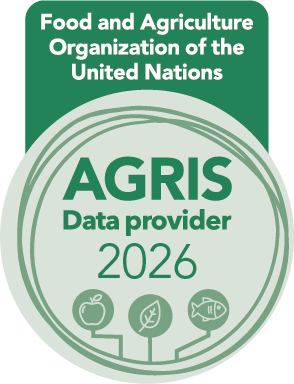Impact of staggered transplanting of pollen parents and repeated pollinationmethods in hybrid seed production of marigold (Tagetes erecta L.)
DOI:
https://doi.org/10.24154/jhs.v20i1.3619Keywords:
Marigold, Repeated pollination, Seed production, Staggered transplanting, SynchronizationAbstract
Marigold is an important commercial flower crop of India and hybrids are in demand. However, the hybrid seeds are being imported due to the limited number of hybrids. Seed production of F1 hybrids needs to be enhanced to reduce the dependency on imported seeds. Therefore, the present study was initiated to work out the strategies for maximizing the hybrid seed production in four hybrid combinations. Seed parents exhibited delayed flowering with an extended duration ranging from 104.89 to 114.50 days, in contrast to the early-flowering pollen parents, which had a shorter flowering duration of 65.39 to 72.28 days. This discrepancy could be effectively addressed by staggered planting of pollen parents at multiple intervals, ensuring consistent pollen availability throughout the active flowering period of the seed parents. Irrespective of the hybrid combinations, repeated pollination for three-time registered higher seed setting percentage (49.56%), more number of seeds (112.79) and higher seed weight (250.67 mg) per flower compared to either one or two time pollinations. The study highlighted the potential for enhanced hybrid seed production through staggered planting of pollen parents combined with repeated pollination, ensuring maximum seed set per flower and optimizing seed yield per unit area of production.
Downloads
References
Anonymous. (2024). *Area and production of horticulture crops for 2023-24 (2nd advance estimates)* (ON3479). Ministry of Agriculture & Farmers Welfare, Government of India. [https://www.indiastatagri.com](https://www.indiastatagri.com)
Devries, D. P., & Dubois, L. A. (1983). Pollen and pollination experiments. X. The effect of repeated pollination on fruit and seed set in crosses between the hybrid tea-rose cvs. Sonia and Ilona. *Euphytica, 32*, 685-689.
https://doi.org/10.1007/BF00021467
Doddagoudar, S. R., Shekhargouda, M., Khadi, B. M., Eshanna, M. R., Biradarpatil, N. K., & Vyakaranahal, B. S. (2008). Studies on planting techniques for synchronization of flowering in DHB-290 cotton hybrid seed production. *Indian Journal of Agricultural Research, 42*(3), 195-200.
Kumar, A., Jamali, A. R., Miano, T. F., Lal, R., Soomro, A. W., Suthar, M., … & Kumar, A. (2023). Response of farmyard manure (FYM) on growth and flowering of different marigold (*Tagetes erecta* L.) varieties. *American Journal of Plant Biology, 8*(2), 30-35.
https://doi.org/10.11648/j.ajpb.20230802.12
Kumar, A., Singh, S. K., Sharma, S. K., Raghava, S. P. S., & Misra, R. L. (2004). Comparison of seed-derived with micropropagated male-sterile plants of *Tagetes erecta* L. for F1 hybrid seed production. *The Journal of Horticultural Science and Biotechnology, 79*(2), 260-266.
https://doi.org/10.1080/14620316.2004.11511758
Kumar, G. A., Ramanappa, T. M., & Siddaraju, R. (2019). Influence of staggered sowing on growth, seed yield and quality of single cross hybrid maize: MAH 14-5 (*Zea mays* L.). *Mysore Journal of Agricultural Sciences, 53*(3), 59-63.
Patil, L., Deshpande, V. K., Chimmalagi, U., & Jeevitha, D. (2023). Overview of seed production in floriculture crops. *International Journal of Environment and Climate Change, 13*(10), 2791-2802.
https://doi.org/10.9734/ijecc/2023/v13i102944
Shaikh, A. A., Ray, A., & Singhal, R. S. (2023). Co-extraction of marigold flowers (*Tagetes erecta* L.) and dried coconut (*Cocos nucifera* L.) shreds using supercritical carbon dioxide: Characterization and functional food formulations. *Food Chemistry Advances, 2,* 100189.
https://doi.org/10.1016/j.focha.2023.100189
Sukwiwat, K., Kumchai, J., Bundithya, W., & Potapohn, N. (2023). Apetaloid and petaloid female performance on horticultural characteristics of F1 American marigold (*Tagetes erecta* L.) hybrids. *SABRAO Journal of Breeding and Genetics, 55*(5), 1754-1767.
https://doi.org/10.54910/sabrao2023.55.5.27
Tejaswini, P., Chandana, B. R., Dedhia, L., & Veeresh. (2024). Status of seed and planting material in floriculture: Strategies and opportunities. In *Souvenir of the National Conference on Recent Trends and Future Prospects of Floriculture in India* (pp. 127-133). ICAR-IIHR.
Tejaswini, T., Sane, A., Gadre, A., & Ghatke, M. (2016). Characterization and utilization of three distinct male sterile systems in marigold (*Tagetes erecta* L.). *The Indian Journal of Agricultural Sciences, 86*(10), 1271-1275.
Downloads
Published
Issue
Section
License
Copyright (c) 2025 R Veeresh Kumar, T U Bharathi, K Hima Bindu, R H Laxman, R Venugopalan, P V R Reddy, Tejaswini Prakash (Author)

This work is licensed under a Creative Commons Attribution-NonCommercial-ShareAlike 4.0 International License.
Authors retain copyright. Articles published are made available as open access articles, distributed under the terms of the Creative Commons Attribution-NonCommercial-ShareAlike 4.0 International License, which permits unrestricted non-commercial use, distribution, and reproduction in any medium, provided the original author and source are credited. 
This journal permits and encourages authors to share their submitted versions (preprints), accepted versions (postprints) and/or published versions (publisher versions) freely under the CC BY-NC-SA 4.0 license while providing bibliographic details that credit, if applicable.







 .
. 











